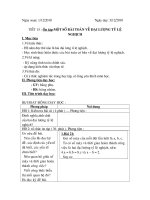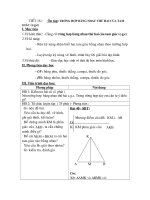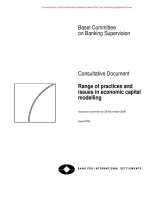OB lecture 7 issues in organizational structure
Bạn đang xem bản rút gọn của tài liệu. Xem và tải ngay bản đầy đủ của tài liệu tại đây (434.65 KB, 36 trang )
Lecture 7
Unit 3 Organizations and Behaviour
Other Issues in Organization Structure
Scope for Today
1.Issues in Organization Theory
2.Assignment 1 – Case Study
New Method for Sharing
Teaching Material
pass: itpf02ba
pass:
itpf03ba
Types of Organization
Structure
1.
2.
3.
4.
5.
6.
7.
Simply Structure (no structure !)
Functional Structure
Team Structure
Matrix Structure
Division Structure (Federal Decentralization)
Stimulated Decentralization
Network or Systems Structure (non –
organization)
A large organization contains several
types
of structure at different levels
7. Issues in Organization
structure
1 Formal and Informal
2 Centralized and Decentralized
3 Tall and flat
4 Span of control
5. Formalization/Standardization
Formal vs. Informal
Page 58 – 59 of Text book
Formal Structure
CEO
Information
Technology
Authority
Purchasing
Reporting
Incoming
Inspection
Human
Resource
s
Communication
Assembly
Assembly
1
Assembly
2
Division of labour
Assembly
3
Quality
Control
Sales
Formal Structure describes how work is
organized (division of labour),
authority
(Unity of Command), and how
information
is passed down (Scalar Chain of
Command)
Informal Structure
There is an informal structure that exists
alone side the formal structure – social
network, cliques, and temporary networks.
- Unwritten Rules (How we do things here)
- Informal channel of communication
(Grapevine)
Informal Structure can be faster and
more
effective.
It is part of the ‘organizational
culture’that
management should pay attention.
Old Dorm for Lecturers in
Beijing
Cleaner
Vincent
Ben
David
Angie
Isabelle
TV
Dinning
Rebuilt
Isabelle
Ben
Which is better for informal structure ?
Kitchen
Angie
Kitchen
Kitchen
David
Vincent
Tall and Flat
Structure
Tall and Short
Tall
Flat
Tall and Flat
Who is handsome?
Advantages and Disadvantages
(page 64)
Malorganization = Sick
Organization
Mal –”sick” in French
The most common and serious symptom
of malorganzation is multiplication of
management level
A basic rule is to build the least possible
number of level
More Layers
Introduces ‘noise’
More layesr make the attainment of
common direction and mutual
understanding.
additional distorts objectives and misdirects
attention
- Peter Drucker
Management Development
If an organization has 12 layers, and an
executive will never reach CEO whie he or
she is still young and vigorous.
12x 5 = 60 years !
Assuming a candidate stays 5 years at one
level
So much noise that
communication is
impossible
Example of Chinese Emperor
Yongzhen
and his invention.
He sent and received letters from his
Generals directly in sealed envelope.
Why So Many Layers ?
Parkinson’s law of Rising Pyramid
“Work expands so as to fill the time available
for its completion”.
If there are A, B and C in a department. If A
too much work, Instead of distribute among
B, and C, A will hire D and F to build
up his/her position.
Delayering
Reduce the number of layers.
Very little value added there is by the
intermediate level.
It is much feasible now with advances in
information technology
What is the minimum
number of layers
3? 5? 6?
Centralization vs
Decentralization
The degree of concentration of
authority
Decentralize if it works









